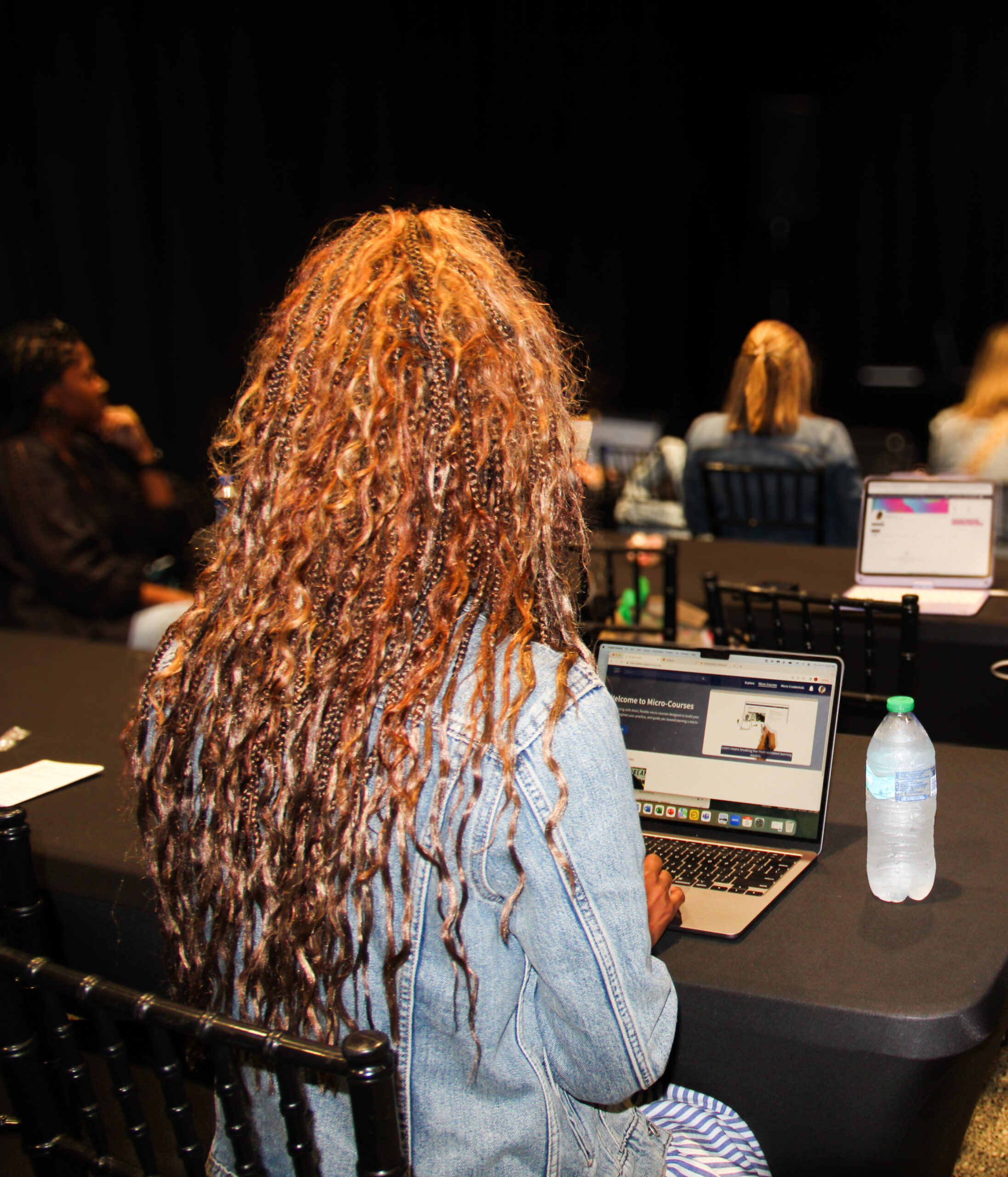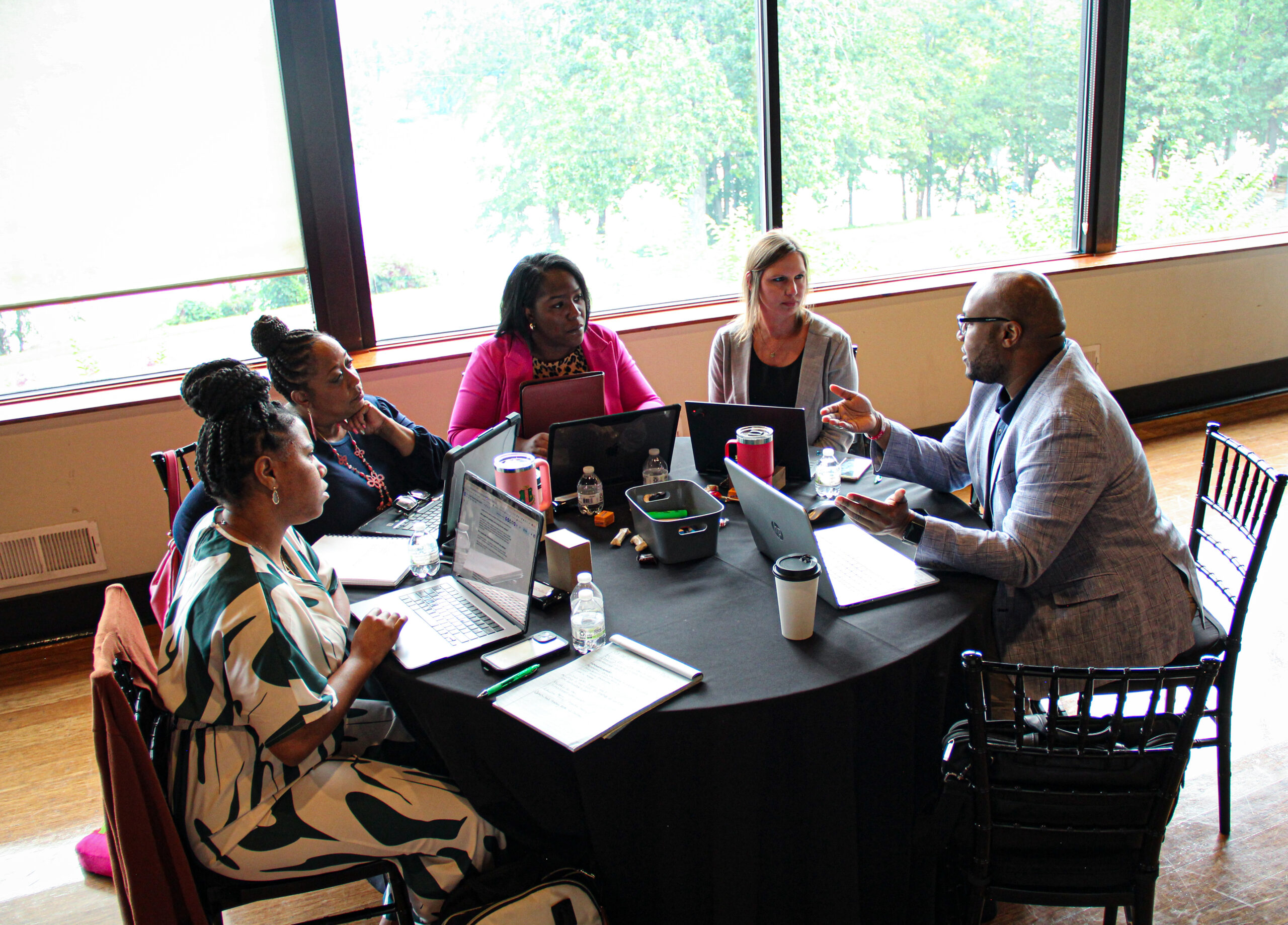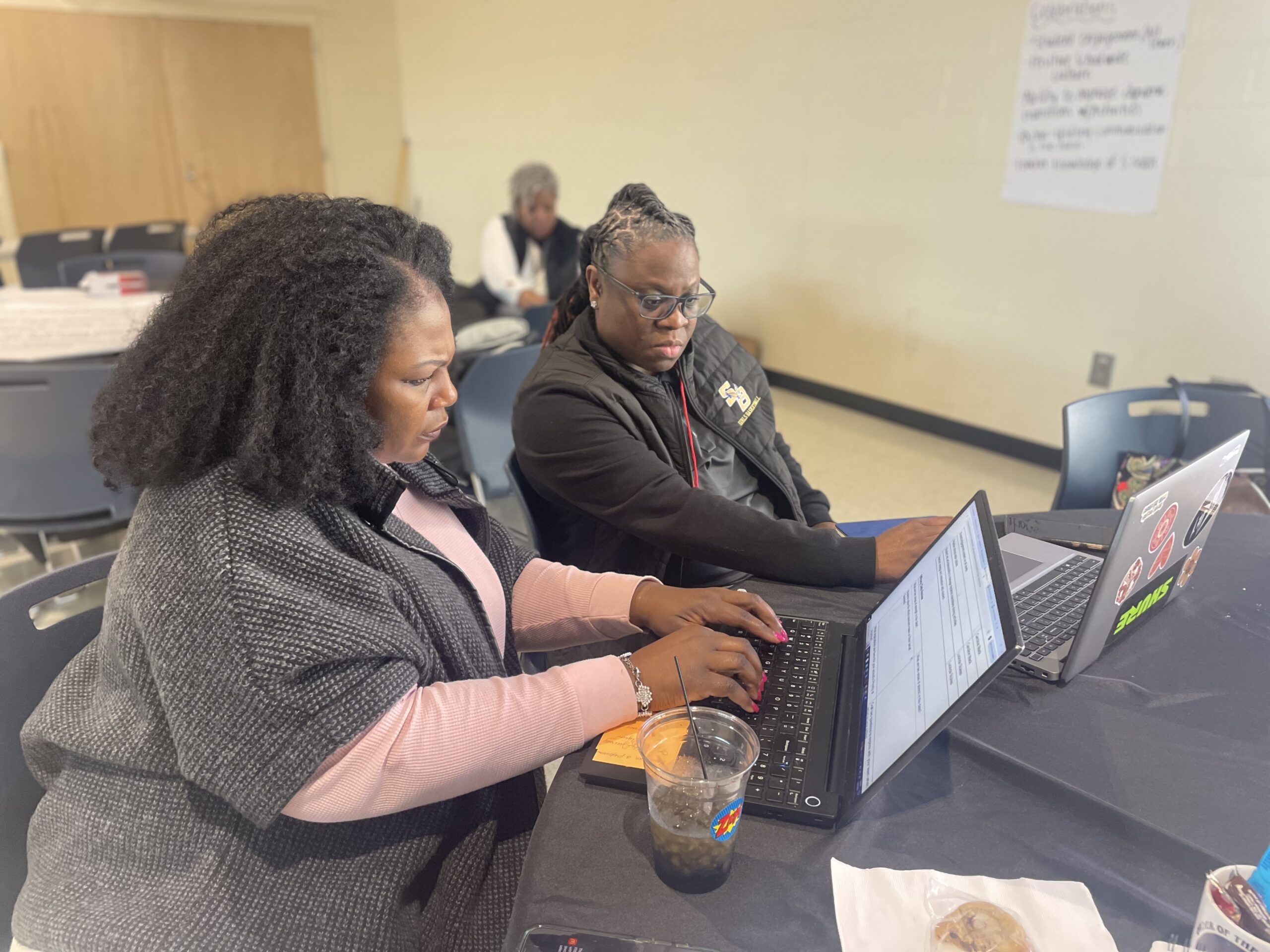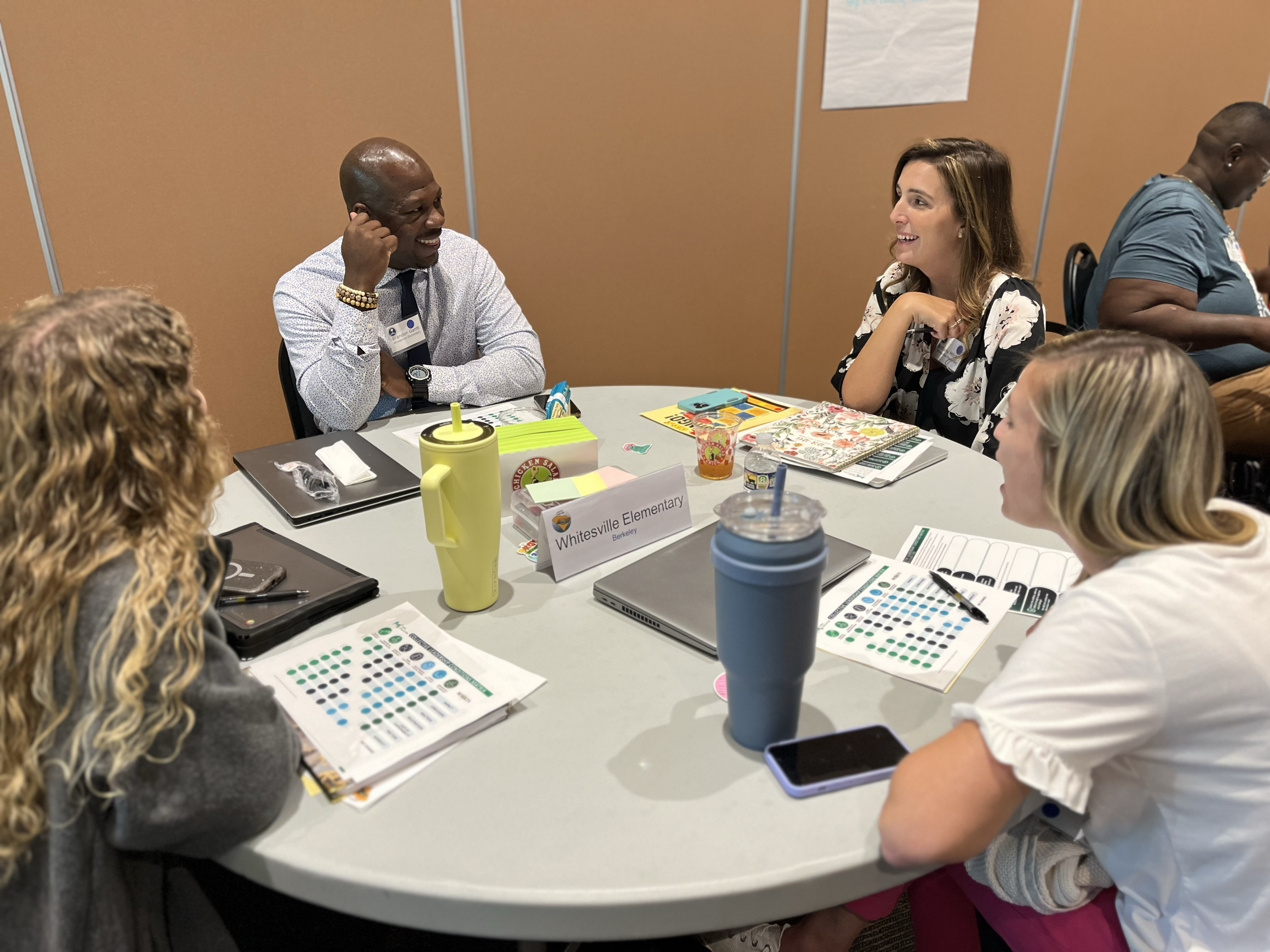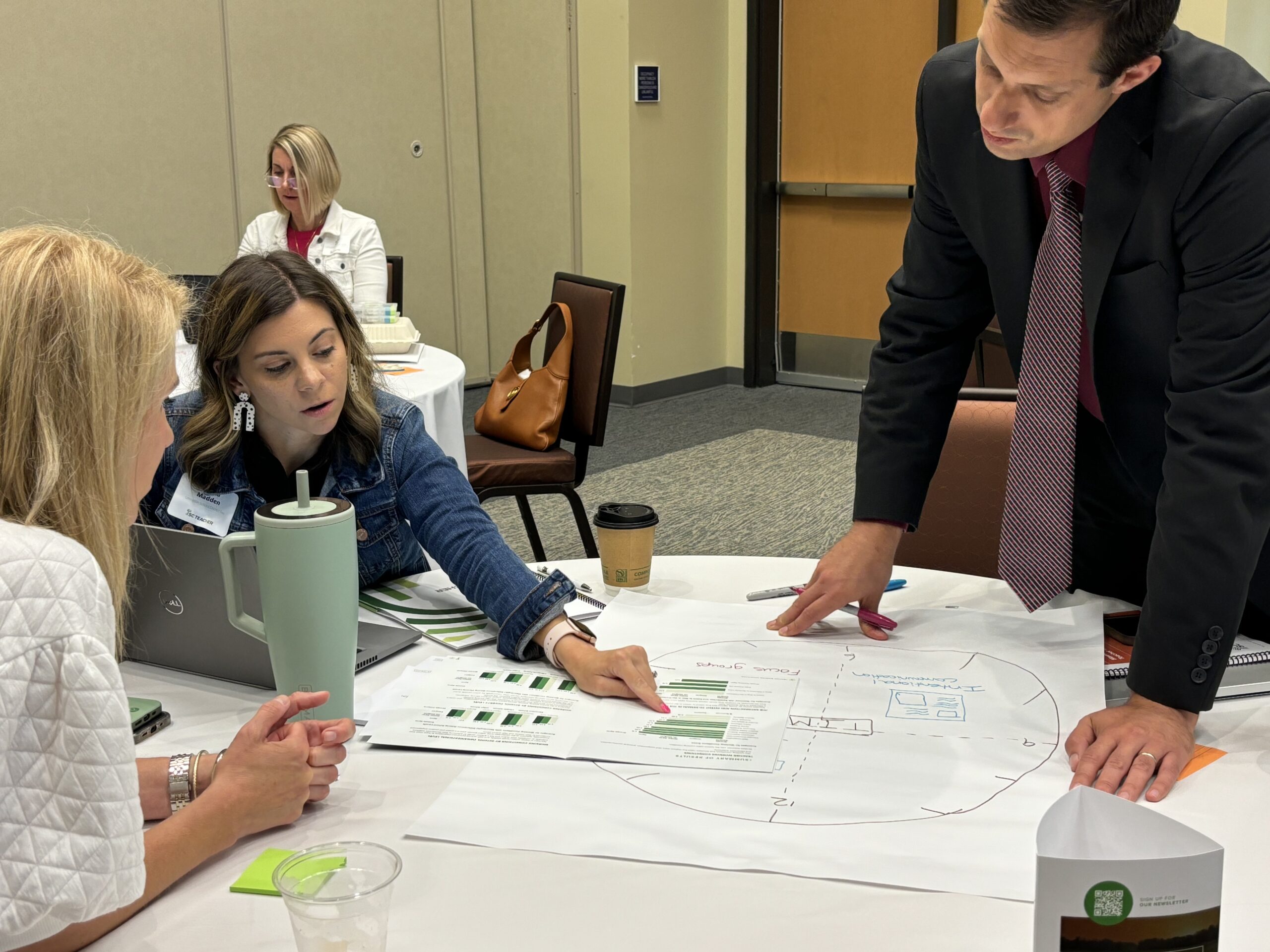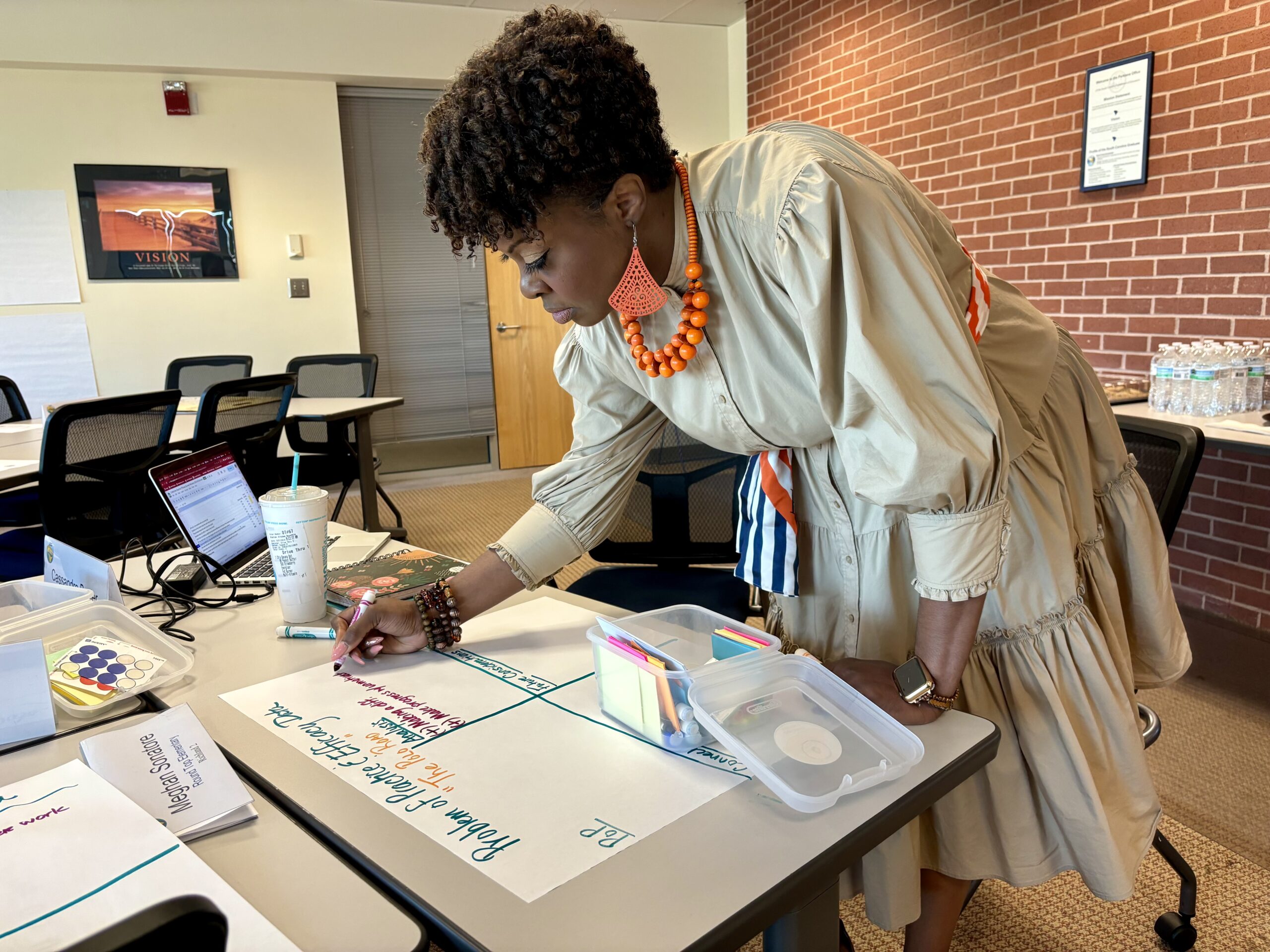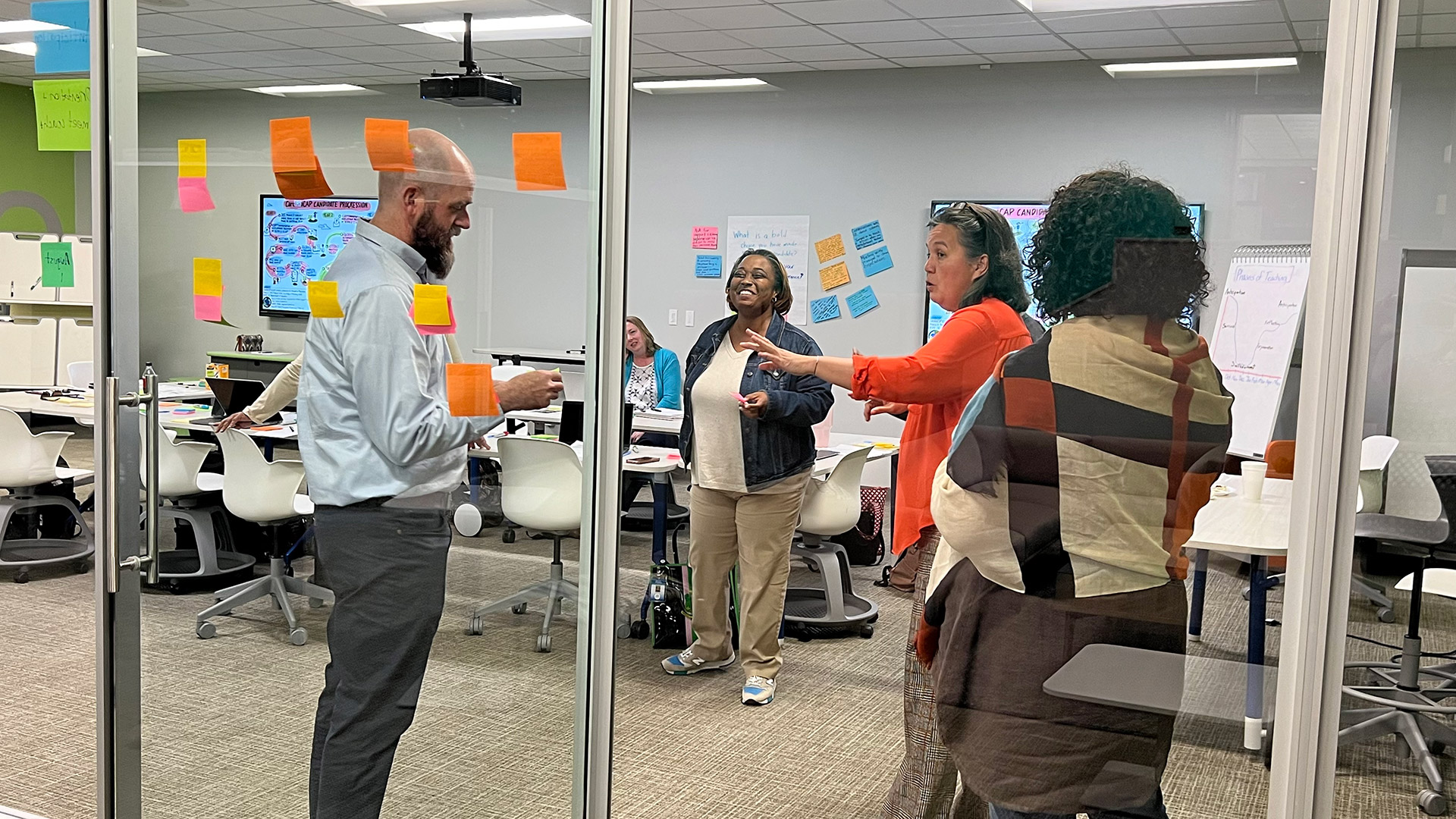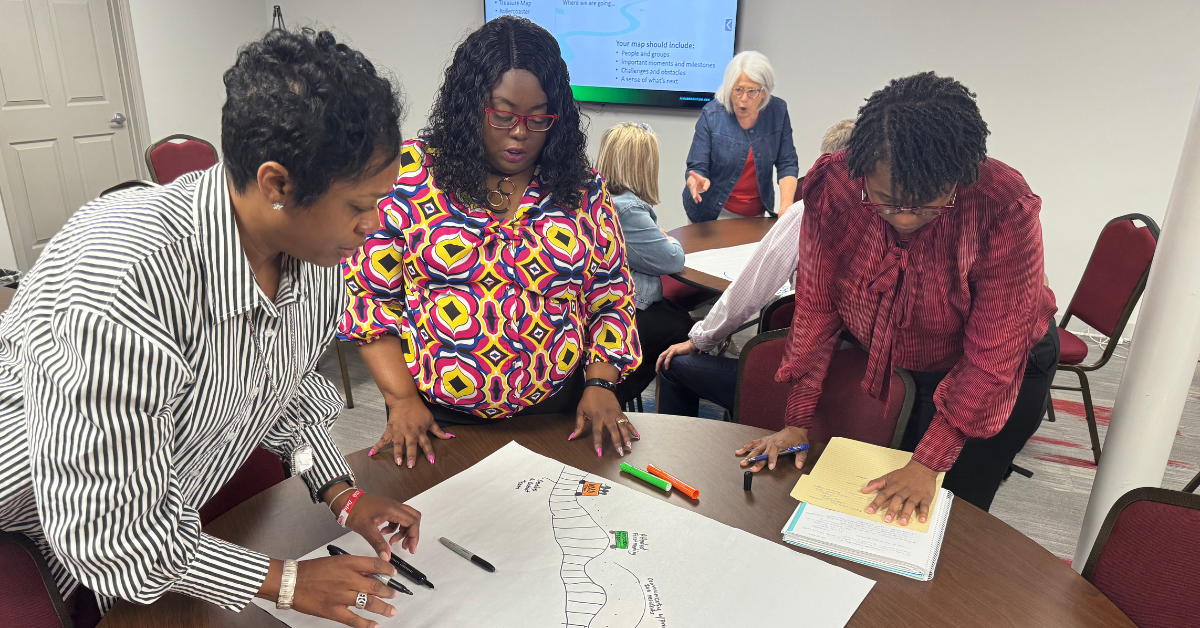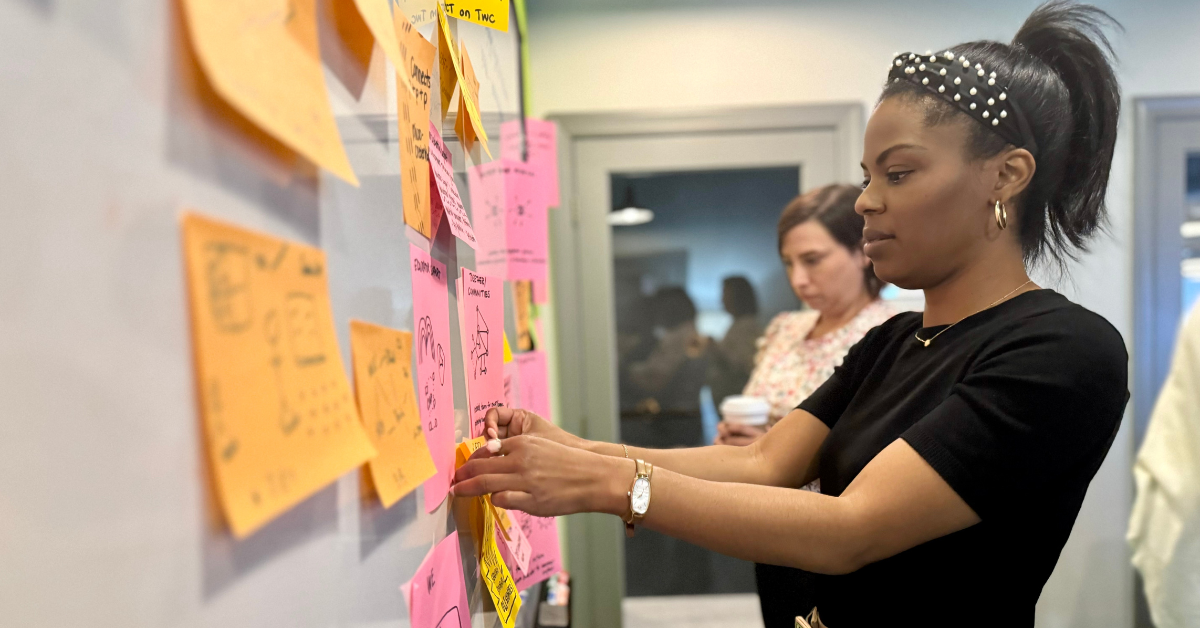System Redesign
Micro-Credentials: Advancing Educator Agency Through Competency-Based Professional Learning
Educators are continuous learners. Yet too often, professional learning opportunities fail to reflect the complexity of their work. Sessions are generalized, disconnected from classroom realities, and rarely result in measurable improvement.
In contrast, micro-credentials offer a more relevant and effective approach, one that recognizes professional learning as a process of inquiry and application. At Mira Education, we have seen how micro-credentials not only validate educators’ skills but also strengthen their capacity to lead learning and improvement within their own systems.
Driving Improvement
Mira Education partners with P20 education organizations to activate collective leadership as a driver of improvement. Our work focuses on three interconnected areas:
- Competency-based professional learning to identify and develop educators’ capacity for transformational change
- Strategic planning, coaching, and facilitation to accelerate collectively led improvement across teams and systems
- Tools and models that scale what works, advancing equity, effectiveness, and sustainable educator support
Our micro-credential development work sits at the intersection of these priorities, helping systems transform professional learning into a structured, evidence-based pathway for educator growth and leadership.
The Challenge: Limited Personalization in Professional Learning
Despite decades of reform efforts, professional learning for educators remains largely compliance-driven. Many opportunities are broad in scope and lack clear application to the contexts in which educators operate. As a result, professional learning is often perceived as time-consuming, low-impact, and disconnected from meaningful outcomes.
Educators need learning experiences that are:
- Personalized to their professional goals and local contexts,
- Grounded in authentic challenges of practice, and
- Recognized as credible measures of growth and leadership.
Micro-credentials address these needs by providing a structure for continuous, evidence-based professional learning.
A Practice-Anchored Approach
Micro-credentials are competency-based certifications that recognize demonstrated proficiency in discrete, practice-aligned skills. Each credential is designed around authentic performance tasks, enabling educators to apply and document their learning in real school settings.
This approach transforms professional learning from a passive experience into an active process of problem-solving and reflection. Educators learn by doing and by demonstrating how their learning drives improvement in outcomes for students and systems.
Evidence of Impact
In partnership with the University of Maryland’s School Improvement Leadership Academy (SILA), Mira Education co-developed two micro-credentials designed to assess proficiency in implementing equitable practices and applying improvement science to address systemic challenges.
This model is yielding measurable results. As of April 2025, 116 enrolled Fellows have earned 136 micro-credentials, and participation continues to grow.
To sustain quality and scalability, Mira Education also trained seven practitioners to serve as certified assessors, facilitating initial training and ongoing calibration sessions to ensure alignment and rigor.
Early outcomes from these partnerships demonstrate that micro-credentialing can:
- Support educators in addressing context-specific needs within their schools,
- Build collective capacity for problem-solving and system change, and
- Reinforce structures that sustain continuous improvement.
Why This Work Matters
Micro-credentials represent a fundamental shift in how professional learning is designed, delivered, and recognized. They move beyond seat time to focus on competence demonstrated in practice, providing a clear and credible measure of growth.
More importantly, they return ownership of professional learning to educators themselves, enabling them to identify priorities, test strategies, and lead improvement from within their own contexts. In this way, micro-credentials do more than codify skills. They cultivate agency, reflection, and collective leadership.
Partnering for System Impact
Mira Education collaborates with higher education institutions, state departments, and school systems to design and implement micro-credential frameworks that align with local priorities and capacity. Each partnership is customized to ensure that micro-credentials are rigorous, relevant, and actionable, driving both individual growth and organizational improvement.
To learn more about how Mira Education can support your organization in developing or expanding a micro-credentialing strategy, visit www.miraeducation.org or contact our team.
Beyond Burnout: Rethinking Support for District Leaders
The Cost of Carrying It All
Every few months, a new headline confirms what many district leaders already know: the job of a superintendent is becoming harder to sustain.
RAND’s 2025 State of the Superintendent survey found that fewer district leaders believe the stress is worth it. Only about half of the respondents agreed that the challenges of the role feel worthwhile, representing a sharp drop from previous years, ultimately leading to the question: why stay? It’s a sentiment growing across roles in the education field.
So, what’s happening?
RAND researchers highlight a potential disconnect: many superintendents are spending time on tasks that don’t align with their vision of leadership, such as facility management, budgeting, and addressing daily operational issues that keep districts running. The irony is that while district size and local politics may shape the pressures of the job, the purpose remains the same across contexts: to create the conditions where great teaching and student learning can thrive.
Burnout Isn’t About Weakness. It’s About Structure.
At Mira Education, we often say burnout isn’t a sign that leaders are doing something wrong. Rather, it’s a sign that the system isn’t built to share leadership well. When too many critical functions run through the central office, the system itself weakens. In most districts, even well-run ones, leadership systems are designed around one singular hub, and every challenge, from staffing shortages to school safety, runs through a narrow channel. Unsustainable pressure isn’t a reflection of an individual leader or office, but a system that is stretched too thin.
It’s no wonder the work feels unsustainable. When leadership isn’t shared, that pressure compounds.
But what if the solution isn’t just more self-care or “work-life balance” training? What if it’s reimagining how leadership itself works?
What Sustainable Leadership Looks Like
In our work with districts nationwide, we’ve seen this come to life in three powerful ways:
1. Clarifying Work Structures – Superintendents and cabinet teams co-create decision-making practices that clarify who leads, who contributes, and how information flows. These structures make collective leadership possible without chaos or duplication. They also allow the superintendent to focus on strategic leadership rather than operational triage.
Tool Spotlight: The Collective Leadership Conditions Matrix: Team Discussion Tool helps teams identify where decision-making or communication bottlenecks exist and how to share ownership more effectively.
2. Strengthening Communication Routines – The most effective leaders co-create predictable, shared rhythms for communication, ones that keep teams aligned without constant check-ins. When communication becomes routine rather than reactive, superintendents regain time and mental bandwidth to think deeply about system improvement.
Tool Spotlight: The Inclusive Communications Discussion Tool guides teams in co-creating norms and channels for clear, purpose-driven communication.
3. Aligning Time and Purpose – Time is a mirror of system design. When superintendents spend most of their days putting out fires, it signals that the leadership structure, rather than the individual, is out of balance. By using tools like improvement cycles, role mapping, and self-reflection, leaders can ensure that time and effort align with district priorities.
Tool Spotlight: The Educator Time Tracker guides superintendents through a three-day self-reflection on time use, enabling them to understand better where and how they spend their time. This allows them to identify trends and make adjustments aligned with their daily and weekly priorities.
Collective leadership offers a structural alternative. Rather than concentrating authority and problem-solving at the top, it creates conditions that enable leadership to be exercised across roles and levels.
When a superintendent leads within a collective leadership framework, they don’t carry every responsibility alone. Instead, they build clear, collaborative systems that distribute thinking, decision-making, and communication in ways that make the district more adaptive and far less fragile.
How are district leaders responding?
We’ve asked current and former district leaders in our network to share how they’re sustaining good work even in high-stress contexts. Their reflections reveal a common thread: sustainable leadership is about intentional structure, connection, and purpose—not heroic endurance.
Dr. Almudena (Almi) G. Abeyta, Superintendent, Chelsea Public Schools, emphasized that the work’s meaning sustains her even on the toughest days:
“For me, especially on the hard days, I remember that I choose to do this job—and that it’s a calling. When the days are hard, whether it’s upset community members or difficult negotiations, I remember it’s about the kids we’re able to impact as a team and the lives we’re changing. In our district, we talk about knowing our students by name, strength, and story… and that’s why I continue to fight and do what I do.”
Dr. Shelly Armstrong, Supervisor of Student Support, shared a simple but powerful weekly structure she calls her “three P’s”:
“A routine that I practice weekly is my three P’s: Priorities, People, and Personal.
I look at what actions directly support district priorities such as student achievement, staff development, or family engagement. I intentionally check in with teams or individuals who may need extra support, encouragement, or recognition. Sustaining good work is about maintaining morale and relationships. I exercise daily, practice gratitude, plan trips, and nurture my relationships.
This structure helps keep me grounded, focused on what’s best for students, and hopefully provides a model for other staff.”
Dr. Kevin Gilbert, Assistant Superintendent, Howard County Public School System, noted that consistent reflection and data review are critical to keeping the system aligned:
“Constantly reviewing data like enrollment, budget, academic, discipline, and more helps me stay focused on district priorities.”
Dr. Carol Kelley, Superintendent, Salem City School District, shared how staying grounded in her “why” and her support network keeps her centered:
“I think you have to remember your why—literally every moment of the day. And I think it’s probably the number one. And then number two, you really have to depend on your support and be intentional about that. And support means your team, yes, but also that group of people who get it, and are a safe space for you. So, literally every Wednesday morning, I have a call with a superintendent friend of mine. It’s our opportunity just to vent… remembering your why and having that circle of support.”
Dr. Ethan Lenker, former Superintendent and current Mira Education partner through STEM East, spoke to the discipline of decision-making in high-pressure moments:
“During stressful situations, people tend to get tunnel vision and rely on gut feelings. Using all available resources—data, colleagues’ expertise, policies, and networks—brings multiple viewpoints into the process. It leads to more strategic, well-supported decisions and models collaborative leadership. Over time, people feel empowered to contribute ideas and support one another during challenges.”
Patrick Miller, former Superintendent and Mira Education partner through STEM East, reflected on leadership through connection and presence:
“One thing that I always tried to do and push on my leadership team is complain up. I encouraged my team and principals to come to me to discuss or vent, not to their subordinates. [The unexpected], such as COVID, book challenges, and budget constraints, all affect people differently, and they needed a safe place to share. For me, being level-headed helped give my staff reassurance. During tense times, I spent more time in schools and community functions—being visible helped people feel at ease.”
Looking Ahead
If fewer superintendents are saying the job feels “worth it,” maybe that’s not a signal for leaders to leave, but a signal for systems to change.
The future of sustainable leadership isn’t about building more personal resilience. It’s about building collective capacity so that the weight of leadership doesn’t crush the people holding it. Because sustainable leadership isn’t about surviving the job, it’s about building systems where thriving is possible.
References
Peetz Stephens, Caitlynn. 2025. “A Growing Number of Superintendents Say the Job Stress Isn’t Worth It.”
Education Week. https://www.edweek.org/leadership/a-growing-number-of-superintendents-say-the-job-stress-isnt-worth-it/2025/10.
Shapiro, Anna and Heather L. Schwartz, State of the Superintendent: Selected Findings from the Spring 2025 American School District Panel. Santa Monica,
CA: RAND Corporation, 2025. https://www.rand.org/pubs/research_reports/RRA956-36.html.
The Invisible Systems That Make Sustainable Leadership Possible
The Practices You Don’t See Until They’re Gone
Some of the most important practices in education aren’t the ones you find in a handbook or see in a school improvement plan. They’re the practices you notice when they aren’t there.
Consider this: when clear communication breaks down, conflict tends to escalate. When norms for collaboration are unclear, meetings tend to drag on, and decisions often stall. When trust is missing, even the best strategies collapse under their own weight.
These “invisible” systems aren’t flashy, but they’re what make leadership collective instead of individual. They quietly hold teams together, keep progress moving, and create the conditions where educators can lead side by side.
What Are “Invisible Systems”?
They’re the routines, norms, and structures that often go unnoticed but fundamentally shape how people work together. Examples include:
- Communication systems: How teams share updates, decisions, and context so everyone stays aligned.
- Norms for collaboration: Agreed-upon ways to handle conflict, give feedback, and celebrate progress.
- Relationship infrastructure: The routines that build and protect trust — like dedicated time for reflection or peer coaching.
When these systems aren’t in place, the cracks show quickly. We’ve seen partners get stuck in cycles of repetitive work or missed opportunities. In one case, a team realized multiple people were tackling the same task while other priorities languished. The missing piece wasn’t effort—it was structure. Without shared processes for communication and feedback, work slipped into silos and results fell short.
Why They Matter for Sustainable Leadership
Leadership thrives when teams don’t have to guess about how to work together.
The right structures:
- Reduce friction by making expectations clear.
- Build predictability, which reinforces trust.
- Ensure each voice has a place and not just the loudest or most senior in the room.
When these systems are missing, it’s easy to fall into silos, turf battles, or decision paralysis. With them, leadership becomes shared, sustainable, and resilient.
One partner learned this the hard way. A leader casually mentioned a new technology tool to a colleague, assuming he would run with the idea. Months later, both were frustrated to realize the suggestion hadn’t landed as intended. What was meant as trust had instead created confusion. The lesson was clear: trust doesn’t mean withholding direction; it means being transparent about decisions and inviting others into the process. As the partner puts it, “[My team] can trust me with the truth.”
Making the Invisible Visible: Practical Examples
Discussion Guides
Tools like Mira Education’s Inclusive Communication Discussion Guide help teams name and address issues that often stay under the surface.
Relationship and Social Norms
Our work on Relationships and Social Norms shows how clarity around collaboration can actually accelerate trust-building. At Horse Creek Academy, teams have invested heavily in norm setting as a foundation for collective work. Far from a box-checking exercise, these norms have become the connective tissue of their collaboration, shaping how colleagues build trust, handle conflict, and sustain progress together. The payoff extends beyond teamwork to teacher satisfaction and long-term retention.
Small Shifts, Meaningful Improvement
Often, it’s not sweeping reforms but small, intentional shifts, such as structured meeting openers or rotating facilitation, that create sustainable improvement.
Across several partnerships, we’ve seen that dedicating time to reflection and coaching isn’t extra. It’s essential. Once teams build collaborative feedback into their routines, it becomes part of their culture and shows up in the results they achieve. It’s what sustains momentum. When collaboration becomes routine, it stops being an “add-on” and instead defines the culture, showing up directly in the results teams achieve.
Trust Lives in the Details
If sustainable leadership is the destination, invisible systems are the road that gets you there. They don’t just support trust. Rather, they are trust in action.
When teams attend to these hidden structures, they create space for educators to lead together, not just alongside each other. That’s how progress becomes lasting and why the smallest details can make the biggest difference.
Start Making the Invisible Visible
Invisible systems don’t build themselves. The sooner teams name and strengthen them, the sooner collaboration becomes second nature. Ready to start? Begin with our Inclusive Communication Guide, or explore how relationships and norms can set the foundation for lasting trust and sustainable leadership.
References
Byrd, P. A., Daughtrey, A., Eckert, J., & Nazareno, L. (2023). Small Shifts, Meaningful Improvement: Collective Leadership Strategies for Schools and Districts. ASCD.
Uncertainty ≠ Instability: 4 Key Strategies for Education Leaders to Support Staff Through Change
Change in education is constant, but uncertainty doesn’t have to lead to instability or getting stuck. Education leaders play a crucial role in navigating the unpredictable nature of school improvement, curriculum shifts, and policy changes. By focusing on what’s within your control and supporting your staff through the unknown, you can lead confidently, reduce stress, and promote a healthy, collaborative school culture.
Here are four actionable strategies to help education leaders support their teams during uncertain times and create stability in change.
1. Focus on What You Can Control: Leadership Strategies for Success
In uncertain times, it’s easy to feel overwhelmed by factors beyond your control, like changes in education policy, fluctuating budgets, or evolving state mandates. However, focusing on what you can control is the most effective way to maintain stability within your team.
You can’t control everything, but you can control your leadership approach: how you communicate, how you advocate for resources, and how you support your staff. By focusing on these areas, you can avoid burnout and build a positive, proactive school culture.
Key Takeaway:
In times of uncertainty, education leaders should focus on the leadership actions and decisions within their control. If it is not yours to do, it is not yours to worry about. This maximizes the impact you can have and fosters resilience.
2. Communicate Early and Often: Building Trust with Transparent Leadership
Effective communication is one of an education leader’s most important tools during change. Proactive communication ensures that staff members are informed, reducing confusion and anxiety about potential shifts.
Whether it’s about curriculum updates, policy changes, or school-wide initiatives, keep your team in the loop early and often. By being transparent and consistent, you prevent assumptions and encourage a culture of trust. Staff should know they can rely on you for updates and information.
Key Takeaway:
Communication is the foundation of trust. Early and frequent updates are key to keeping staff informed and reducing uncertainty during periods of change.
3. Avoid Siloed Decision-Making: Promoting Collaboration Across Teams
Siloed decision-making can lead to misalignment and frustration, especially when facing uncertain times. When teams or leaders work in isolation, it often results in confusion and resistance to change. Instead, promote collaboration across teams and departments to ensure alignment and foster a shared sense of ownership.
Involve staff in decision-making processes early on and create open channels for feedback and collaboration. This ensures decisions are made with collective input, which boosts morale and reduces the risk of misunderstandings.
Key Takeaway:
Collaboration is essential for navigating uncertainty. Break down silos by ensuring decisions are made with input from all stakeholders, aligning your efforts across teams and departments.
4. Make Small Shifts for Meaningful Improvement: Sustainable School Change
Instead of waiting for large-scale changes, focus on small, incremental shifts that will drive long-term improvement. In times of uncertainty, making steady, manageable changes is more sustainable and less disruptive.
Rather than overhauling systems or processes, make consistent adjustments that can be refined over time. Whether revising a program, testing a new strategy, or making small tweaks to daily operations, these incremental changes lead to sustainable growth.
Key Takeaway:
Sustainable change comes from small, intentional shifts. Focus on incremental improvements rather than major disruptions for more significant long-term impact.
Looking for More Resources?
Leading during uncertain times doesn’t have to be overwhelming. By focusing on what you can control, communicating effectively, promoting collaboration, and making incremental improvements, you can guide your staff through unpredictable changes confidently and clearly.
For more tools and resources on leading through school change and supporting your team during uncertainty, visit www.miraeducation.org. Our free resources can help you lead for sustainable change and build a stronger, more resilient school culture.
Removing Barriers to Impact: How Education Leaders Can Find Focus in the Chaos
Why Education Leaders Get Stuck
Education leadership is filled with competing priorities — curriculum implementation, teacher retention, student success, and operational challenges. With so much happening at once, even the best plans can stall.
Maybe a new initiative isn’t gaining traction. Maybe a curriculum shift hasn’t delivered the expected student growth. Or maybe, despite endless meetings, the same challenges persist year after year.
When this happens, it’s often not because the ideas are wrong — it’s because barriers, like follow-through, misalignment, and outside factors, prevent real progress.
The solution? Removing barriers to impact — focusing on what truly matters and clearing the path for meaningful change.
How to Remove Barriers and Gain Momentum
As a design and implementation partner, we’ve helped school and district leaders refine their vision and strategy to meet their unique needs. The key? Harnessing collective leadership, aligning expertise with goals, and identifying what’s standing in the way of progress.
Here are three powerful ways education leaders can remove barriers, focus their efforts, and drive sustainable impact:
1. Leverage Expertise: Leadership is a Team Sport
The best school and district leaders don’t try to do it all alone. Collective leadership ensures that the right people are making decisions in their areas of expertise. When teams collaborate effectively, they remove roadblocks that slow down progress.
Action Step: Identify key strengths within your team. Who can take the lead in specific areas? How can you build leadership capacity across your school or district?
2. Step Back & Reflect: Use Data to Identify Roadblocks
Great education leaders don’t just collect data — they use it to pinpoint barriers and adjust strategies. Reflection isn’t just about checking progress; it’s about identifying what’s holding your team back.
Action Step: Schedule a data-driven reflection session with your team. Use both qualitative and quantitative data to assess progress, celebrate small wins, and adjust your school improvement plan accordingly. Download this tool to guide your session.
3. Turn Reflection into Action: Remove What No Longer Works
Reflection without action leads to frustration. The most effective education leaders take insights and turn them into concrete next steps—especially when it means eliminating outdated practices.
Action Step: After every strategy session, define one priority, assign ownership, and set a clear timeline for action. Removing unnecessary tasks and refining focus helps teams gain momentum. Download this tool to help you sort through initiatives and tasks to refine or remove.
Removing Barriers to Impact: A Mindset Shift for Education Leaders
Progress doesn’t come from doing more — it comes from focusing on what truly moves the needle. By stepping back, leveraging your team, and committing to actionable school leadership strategies, you can clear obstacles and create lasting change.
Feeling stuck? Let’s remove the barriers to impact together. Connect with Mira Education to build momentum and implement high-impact, sustainable school improvement solutions.
Onboarding with Intention: 3 Shifts to Improve the Process
The start of the school year is filled with energy, optimism, and intention-setting for everyone, and especially for new staff who will teach and lead alongside us this fall. The excitement and rush of a new year are terrific moments to engage new staff positively, but can also create special challenges for focused support that have to be addressed if we want to retain as well as onboard these colleagues.
As you prepare for new staff members, three mindset shifts can give the onboarding process fresh intentionality and purpose.
Onboarding Goes Beyond Orientation
Effective onboarding is an ongoing process that takes place over an extended period of time. Though onboarding can include aspects of orientation and training, it goes well beyond that.
Onboarding is defined as the action or process of integrating a new employee into an organization. In these times of teacher shortages and retention challenges, it is crucial that onboarding not only prepares new staff for work success but also creates a sense of belonging which can improve retention.
Consider the following questions as you design onboarding to actively engage new staff in the daily practices of your school or district.
Three Questions to Shift Onboarding Beyond Orientation:
- How might we learn of the expertise that new staff brings to the work and share the expertise that already exists with them?
- What structures might we put in place to integrate new staff members into the culture of our school/district by networking our practice?
- How might we build a sense of ownership and mutual responsibility for learning design and outcomes?
How your team chooses to onboard staff sets the pace and tone for the rest of the school year for not only new team members but also for all those who interact with them. While there are a number of ideas and tools for onboarding, at the end of the day, small shifts in onboarding can add up to large impacts on staff success, retention, and belonging.
What mindsets are you shifting this school year?
Connect with Mira Education to jumpstart your onboarding practices. Let’s reimagine onboarding together.
For P20 education organizations seeking solutions to complex challenges, Mira Education is a proven design and implementation partner that applies a unique collective leadership approach to sustainable systems change to positively impact leading and learning.
Learn more about how we connect the dots among expertise and resources.
Prioritizing Teacher Agency: A Tool for School Improvement
Preparing students for success is complex work. Fortunately, we have found that teachers are ready and willing to take on the challenge of meeting the needs of this complex work alongside administrators. In fact, that is why many teachers entered the profession and continue to pioneer new approaches to learning. Teachers lead classrooms every day and seek to continuously learn and grow in their profession.
Even a decade ago, one in four teachers indicated interest in leading beyond their classroom (MetLife, 2013). Professional autonomy remains a consideration for retaining teachers; a recent survey found that teachers cited the ability to influence decision-making at a school level as one of their considerations for professional satisfaction and retention (SC TEACHER, 2023). By tapping into educators’ talent, school and district administrators can leverage teacher efficacy and agency to better prepare students to succeed in an increasingly dynamic world.
The Collective Leadership Approach
These factors led the South Carolina Department of Education (SCDE) and Mira Education to create the Collective Leadership Initiative (CLI) that explicitly supports the development of agency and leadership across teams that include teachers, coaches, and principals.
Collective leadership leverages the capacity of educators in many roles to accomplish complex leadership work, within and across schools. We know that collective leadership is moderately to strongly correlated to collective teacher efficacy and, thereby, student outcomes (Eckert, Morgan, and Daughtrey, 2023).
Through this effort, we have witnessed collective leadership positively impact student outcomes, teacher retention, and a number of other school factors. One CLI school, Walker Gamble Elementary, has gone from being designated as an underperforming, to receiving statewide recognition as one of South Carolina’s Palmetto’s Finest, to becoming a National Elementary and Secondary Education Act (ESEA) Distinguished School. Importantly, the school continues to be a Title I campus, has not added new positions or hours to the schedule, and has not radically restaffed. Instead, its CLI team found ways to better connect the resources they already had within their building to meet student needs.
Other schools that have integrated collective leadership into how they approach their work report increases in student academic growth, student leadership, teacher leadership, positive responses about school environment, and decreases in discipline. Many are considered destination schools; when vacancies open, high quality teachers apply because they want to be a part of those teams.
Not only does collective leadership move the needle on some of the biggest challenges in education, but it creates space for leadership opportunities where teachers can exercise agency. Moreover, it signals trust in teacher professionalism. As Amanda Williamson, teacher at Walker Gamble Elementary said, “When you allow me to exercise agency and do what’s right for my students…I truly feel like I’m looked at as a trusted professional.”
So, what are some of the keys to building teacher agency and collective leadership? We suggest you begin with priority setting.
Priorities
Effectiveness over efficiency
Let’s be honest: collaboration is less efficient than agency without parameters, but collaboration done intentionally has a compounding positive impact. The hope of collective leadership is that collaboration — even if it takes longer and involves understanding the perspectives and thoughts of people who think differently — multiplies the expertise of the group and makes both collective and individual actions even more effective. When school and district leaders help groups understand the strengths of individual team members, outline roles and responsibilities, and clearly describe which tasks are collaborative and which tasks are independent, teachers are enabled to use their talents freely.
Through CLI, the SCDE has had to figure out the balance between what we insist upon – the requirements every school must meet – and what we assist with – the supports and experiences that are unique to schools. Where we’ve landed is that every school collects the same efficacy and conditions data, but individual schools can choose where to focus their improvement efforts and what additional data they will collect to show progress toward that goal.
Personalized over programland
In addition to prioritizing effectiveness, we must also prioritize a personalized approach toward improvement rather than a cookie-cutter solution. We share from experience that it’s easy as a systems leader to get stuck in “programland”. In programland, our theories of action sound like this: “If our organization invests in getting schools to implement the program with fidelity, then the strength of the program will help our schools improve.” Living in programland is easy and while many programs are evidence-based and effective, they can be costly. Furthermore, to be successful, programs often need both buy-in and consistency – a lofty goal in an already demanding profession. If we view teacher leadership and agency as a one-size fits all program, we run the risk of preparing teachers for leadership roles that may never materialize in their context.
So, if we want teacher agency to be sustainable, we must exit programland and model collective leadership with the schools and districts we serve. When shifting to collective leadership, we can start by listening and asking the questions teachers are most apt to answer.
- What specific needs is the school seeing?
- What are the leadership strengths of the faculty?
- What are the specific strengths and areas for growth in classroom instruction?
- What support or professional development would help teachers and administrators grow in their ability to improve the school?
We encourage districts and states to start small with a group of schools that are interested in growing the capacity of teachers. A book study on collective leadership or a commitment to collecting and sharing data around a problem of practice are great places to start. Our book, Small Shifts, Meaningful Improvement offers both case studies from CLI as well as tools for teams to pilot their own collective leadership approach.
Cost-efficient and continuous over costly and complicated
Collective leadership that integrates teacher agency is not costly or complicated. However, it can be difficult to implement because it takes time and focus. It takes time to craft the school calendar and schedule so that teachers and administrators have opportunities to collaborate. It takes discipline to focus resources and conversation on learning and teaching. It takes sustained effort to develop teachers’ leadership. It takes skill to build the trusting relationships between and among faculty, students, and families that enable growth. What South Carolina collective leadership schools are learning is that taking the time to create systems that grow teacher leadership is worth it.
What collective leadership does NOT take is adding another thing to educators’ already full plates. It requires rethinking how educators–together–approach the complex work of preparing students. Dr. Cassandra Bosier, Principal at a CLI participating school, puts it best: “The only thing I am adding is opportunity.”
When your priorities are effective, personalized, cost-efficient and continuous, you create space for collective leadership and teacher agency to thrive.
Ultimately, preparing students to succeed in our increasingly complex world is going to require that we leverage the expertise of all educators. Prioritizing efforts that build and leverage teacher efficacy that are effective, personalized, and cost efficient are key to ensuring the student outcomes that we need and support the teachers who do the hard work every day.
To learn more about CLI visit the SCDE website and for more collective tools and resources visit www.miraeducation.org/tools.
Bibliography
Jonathan Eckert, Grant Morgan & Alesha Daughtrey (2023): Collective School Leadership and Collective Teacher Efficacy through Turbulence, Leadership and Policy in Schools, DOI: 10.1080/15700763.2023.2239894
MetLife. (2013). (rep.). The MetLife Survey of the American Teacher: Challenges for School Leadership. Retrieved November 27, 2023, from https://files.eric.ed.gov/fulltext/ED542202.pdf.
Starrett, A., Dmitrieva, S., Raygoza, A., Carti!, B., Gao, R., Ferguson, S., Quiroz, B., & Tran, H. (2023 November). 2023 Teacher Working Conditions in South Carolina Rural and Town Schools. SC TEACHER. https://sc-teacher.org/documents/twc-23-rural-and-town/
Doing More With Less: Preparing for the ESSER Funding Cliff
Next fall’s $190 billion federal funding cliff may be causing almost as many sleepless nights as the pandemic did. For superintendents and other K12 district leaders, early Elementary and Secondary School Emergency Relief (ESSER) funds were essential for one-time emergency spending. Later, districts spent more to address learning loss, staffing needs, and other capacity-building to support full recovery.
Assessments of learning loss and equity implications for communities suggest that full recovery from the pandemic is far from finished, even if ESSER funding is ending. It’s easy to build an argument that schools need more base funding to continue to hire and retain educators, restore long-vacant positions for counseling and other student supports, and provide intensive programs for targeted students.
But the reality is that districts and states will have to identify cuts with the end of ESSER funding. The sooner and more thoughtfully districts can begin planning, the better. Budget cuts are unavoidable, but district leadership teams can use this as an opportunity to focus on what is actually important. Four practices can make sure that the cliff doesn’t send you into a free-fall.
Take time to articulate priorities.
From paraprofessionals to the superintendent’s office, educators across all roles agree on one thing: they never have enough money or time. While it’s hard to make more of either, we can choose how we spend both. That means getting distinct about what is most important – not just what’s ideal or urgent – and putting all our energy and resources behind just those things.
The daily urgencies of our work can make it challenging to take the time to identify these top priorities, let alone articulate them for school communities. But it’s an essential first step. If we don’t know our priorities, we can’t protect them — and that means cuts will be felt even more deeply.
De-silo the decision-making process.
Defining “priorities” depends on your perspective. Meeting the needs of 30 individual students and determining what works at the district scale are and should be entirely different viewpoints for decision-making, even when they both seek to center learners’ needs. When those viewpoints aren’t reconciled, leadership teams tend to rely on a combination of mandates, roll-outs, and seeking buy-in to encourage alignment with tough calls.
While leadership requires those tough calls, it need not require tough talk.
The harder the decisions are — and cuts of this type will be very hard — the more important it is to communicate about priorities with others and not just to them.
In over a decade of helping school and district teams tackle challenging changes, our organization has never seen a single “roll-out” of an important decision work smoothly based on an announcement. Rather, it requires consistent and connected communication that links back to the priorities you’ve already discussed together.
The time spent to share ideas, ask questions, and seek input is significant, but it is much less time — and much less stressful time — than the time that leadership teams otherwise need to spend in contentious bargaining tables, staff meetings, public hearings, and press conferences.
Fight the epidemic of “program-itis.”
Even evidence-based programs with robust support from skilled educators can fall short of their promise for students and schools. And that can sometimes be the best-case scenario. Many, if not most, of the programs that districts and schools plan to implement, require extensive (and expensive) training for staff before they can get off the ground or demand total fidelity to work as promised.
Sometimes there are just too many programs to be done well. In one improvement leadership network we have supported, school leadership teams identified more than 30 programs adopted in relatively small elementary schools. When staff are struggling just to name all the programs they have in place, it’s a good bet that they are struggling to run them.
Programs should support students and educators – not the other way around. Budget cuts not only offer us the opportunity to trim away what’s not aligned with priorities and getting results, but also to think about what is really sustainable. No matter how much money you have to spend on potentially effective and helpful programs, too many of them create a deficit of time and energy that contributes to stress, burnout, and attrition while doing little for student learning.
Plan proactively.
K12 education continues to be asked to do more with less. The repercussions of cutbacks are real, as is the stress that these decisions place on district leadership teams and personnel. But we can buffer those impacts if we shift from a focus on scarcity, which engenders feelings of restriction and dread, and replace it with a planned focus on opportunities to shed that programmatic “clutter” in ways that help us serve students better in the long run.
Our book, Small Shifts, Meaningful Change, offers a protocol in Chapter 4 to help you bring all these ideas together to reimagine your resources as part of a single 90-minute meeting. You can find more free tools and discussion guides on Mira Education’s website or contact our team for advice and support.
3 Reflections to Lead School Improvement Planning
The end of the school year calls for both reflection and planning. In the midst of drafting master schedules and reimagining resources, school leadership teams must also take stock of what worked and what no longer serves their students and staff.
Assessing impact in the current year while also planning for the next can be overwhelming. It is even more so when you consider the increasing number of priorities that come with closing out the school year like standardized testing, setting the budget, and end-of-year celebrations – just to name a few.
There is an abundance of “how-tos” and “how-nots” when it comes to school improvement planning, but the expertise needed to make the right decisions for your school or district often lies within your team.
Use these three reflection prompts to unpack this school year and plan for the next.
1. At the beginning of the school year, what was the vision and goals for your students? For your team? How was that vision crafted?
A clear vision and strategy help orient your team and your shared work. Identifying a vision for both achievement and experience is paramount to shifting the work toward your desired outcomes. As you think about your vision for this last school year, recall how it was developed. Was it done alone or were others invited into the process?
By inviting others into the vision and strategy creation process, leadership multiplies. As the next iteration of the vision is developed, leverage the expertise across your team and across roles to increase the ownership of vision, strategy, and outcomes.
2. How did you support your team in the facilitation of this vision?
Supportive administration, whether on the district or the school level, is a key part of retaining talent and expertise. How leaders choose to not just involve staff in the vision and strategy but also support the work is pivotal for both retention and seeing that vision come to fruition. According to the EdWeek Research Center, of educators polled, having a more supportive principal/manager was the top reason they chose to stay in the profession.
As you reflect on this past year, what supports did you and other leaders offer to your team? Where could you shift your practice to be more supportive and attuned to staff needs?
3. How were capacity and resources aligned to support the vision and strategy for the year?
Capacity and resources are finite. That is a universal truth across education and across roles within each district and school. How you organize capacity and resources, however, can significantly impact the realization of your shared vision and strategy.
Consider how your team spent time this year. Was collaboration and planning time prioritized in the schedule? Was there space for cross-team learning? Time is just one of many resources you can leverage in support of your vision. Download our tool, Reimagining Your Resources, to facilitate a 90-minute discussion and recalibrate your resources to your shared vision.
As you dive into reflection, we invite you to extend that into team learning and discussion. Check out our book, Small Shifts, Meaningful Improvement, for additional tools and case studies on how to apply a collective leadership approach to your school improvement planning.
Planning for Shifts: 3 Approaches as ESSER Ends
Education was interrupted in 2020. From virtual learning to Personal Protective Equipment (PPE), the COVID-19 pandemic caused a significant shift in the profession. In response, the federal government bolstered district budgets with COVID relief funds. Now, just four years later, district leaders must shift again as those funds come to an end. Before the next school year, they will make hard decisions around ESSER funding and must pivot to meet the needs of students and staff.
What is ESSER funding?
The Elementary and Secondary School Emergency Relief Fund, commonly referred to as ESSER, is a federal program that gave districts nearly $190 billion in response to the pandemic. Districts have until the end of September to commit their share of ESSER funds and will have until January 2025 to spend them.
For some districts, ESSER funds allowed for new construction in response to growing communities. For others, it meant hiring more staff to support student needs. No matter where districts invested their funding, the time is coming for district leaders to make shifts in order to maintain momentum.
Planning for Shifts: 3 Approaches as ESSER Ends
Shifts in how districts and schools operate without ESSER funding are inevitable. Cuts are coming, if not already here. But instead of embracing a scarcity mindset, district and school leaders can proactively plan for change. These shifts won’t happen overnight and may be uncomfortable, but they present themselves as an opportunity to re-engage the people who make the work of districts and schools possible – educators.
1. Revisit Your Vision
In your leadership practice, how you approach vision and strategy is as important as the vision and strategy you set. Intentionally invite your team to help co-create the vision and strategy for next year. Though resources are shifting, what you decide as a team is priority will help you gain insight into where to make shifts.
At Manning High School, for example, after experiencing a year of growth, their team wanted to build on that momentum. In the 2023-2024 school year, they came together to rally behind a vision to Watch Achievement Rise or their “W.A.R.” cry to increase student outcomes. By engaging their entire school community in a vision of excellence, they saw a positive impact on report card metrics, discipline, attendance, and enrollment.
As you establish vision and strategy, use this facilitation guide to identify and connect with a range of team members and invite them into the decision-making process.
2. Reimagine Your Resources
After you’ve co-created the vision and strategy with your team, aligning resources is a critical next step to not only seeing that vision come to fruition but also sustaining shifts in your work. How you make strategic sense of existing programs and initiatives will allow you to let go of what’s no longer serving your team and make space for more of what is moving you closer to the set vision.
Walker-Gamble Elementary, an under-resourced school in rural South Carolina, has approached their resources in a way that centers teacher time and student outcomes. By making shifts in their master schedule, every teacher has at least five hours each week for professional learning and collaboration, 75 percent of students experience 1:1 instruction, and every student and educator sets data-informed personalized learning goals at least quarterly (Byrd et al., 2023). By making small shifts in their schedule and reimagining how they work together with their existing resources, Walker-Gamble received South Carolina’s top recognition for schools, the Palmetto’s Finest award in 2020.
Use this activity protocol to guide your thinking and reflect on existing programs and resources with your team. You will need up to 90 minutes for this work.
3. Embrace Fresh Perspectives
Finally, the work of leaders should not be done alone. As ESSER funding comes to an end, invite new perspectives into the planning and implementation of shifts in your shared work. By de-siloing the work to be done, your team becomes co-owners of your outcomes, strategy and vision, multiplying the leadership across your team.
In Richland County School District Two, district leaders are tapping into teacher expertise as part of the planning process for the next school year. To increase teacher engagement in decision-making, they have asked teachers to develop master schedules for the next year to center teacher capacity and time needs.
Creating change and improvement in schools and districts is complex, challenging work. Use this discussion tool with your team to gain insight into your work together.
From Planning to Action
As you prepare for shifts in the new school year, continue to engage your team in the design and implementation of solutions. You can find more free tools and resources on our website or contact our team for thought partnership and support.
